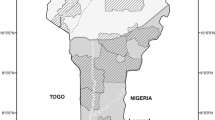Abstract
Over the last two decades, home garden studies have markedly increased in both developed and developing countries. However, garden design and its influence on the overall biodiversity of the urban green infrastructure remains a neglected aspect of home garden research. Home garden surveys were conducted in the North West and Gauteng Provinces of South Africa to contribute to this research focus. The two questions asked in this paper were: (1) Are Batswana garden designs associated with socioeconomic status (SES)? (2) Are the different garden designs characterized by specific plant species richness patterns? We hypothesized that SES influences garden design and that, as the SES of Batswana residents increases, the garden design changes from tshimo to colonial. Our results indicated that garden design reflected less cultural influences and took on a more Westernized colonial design appearance with improvement of SES of Batswana inhabitants. Tshimo gardens tended to have more native and utilitarian species. In contrast, colonial gardens have more alien ornamental species. In affluent areas, sampled Batswana gardens completely changed from a tshimo to colonial garden design. This change indicates that improved socioeconomic status overrides traditional cultural practices.







Similar content being viewed by others
References
Blanckaert I, Swennen RL, Flores MP, López RR, Saade RL (2004) Floristic composition, plant uses and management practices in home gardens of San Rafael Coxcatlán, Valley of Tehuacán-Cuicatlán, Mexico. J Arid Environ 57:39–62
Clarke KR, Gorley RN (2006) PRIMER v6: User Manual/Tutorial. PRIMER-E, Plymouth
Conservation of Agricultural Resources Act (CARA) (1983) (Act No 43 of 1983) http://www.nda.agric.za/docs/act43/eng.htm. Accessed 20 June 2011
Corrigan MP (2011) Growing what you eat: developing community gardens in Baltimore, Maryland. Appl Geogr 31:1232–1241. doi:10.1016/j.apgeog.2011.01.017
Daniels GD, Kirkpatrick JB (2006) Comparing the characteristics of front and back domestic gardens in Hobart, Tasmania, Australia. Landsc Urban Plan 78:344–352
Das T, Das AK (2005) Inventorying plant biodiversity in home gardens: a case study in Barak Valley, Assam, North East India. Curr Sci (Bangalore) 89:155–163
Davoren E (2009) Plant diversity patterns of a settlement in the North-West Province, South Africa. North-West University, Potchefstroom. http://hdl.handle.net/10394/5676
Dorney JR, Guntenspergen GR, Keough JR, Stearns F (1984) Composition and structure of an urban woody plant community. Urban Ecol 8:69–90
Environmental Systems Research Institute (ESRI) (2006) ArcView 9.2. ESRI, Redlands
Gaston KJ, Smith RM, Thompson K, Warren PH (2005) Urban domestic gardens (II): experimental tests of methods for increasing biodiversity. Biodivers Conserv 14:395–413
Graham S, Connell S (2006) Nurturing relationships: the gardens of Greek and Vietnamese migrants in Marrickville, Sydney. Aust Geogr 37:375–393. doi:10.1080/00049180600954799
Head L, Muir P, Hampel E (2004) Australian backyard gardens and the journey of migration. Geogr Rev 94:326–347
High C, Shackleton M (2000) The comparative value of wild and domestic plants in home gardens of a South African rural village. Agrofor Syst 48:141–156
Hope D, Gries C, Zhu W, Fagan WF, Redman CL, Grimm NB, Nelson AL, Martin C, Kinzig A (2003) Socioeconomics drive urban plant diversity. Proc Natl Acad Sci USA 100:8788–8792. doi:10.1073/PNAS/1537557100
Ignatieva ME, Stewart GH (2009) Homogeneity of urban biotopes and similarity of landscape design language in former colonial cities. In: McDonnell MJ, Hahs AK, Breuste JH (eds) Ecology of cities and towns: a comparative approach. Cambridge University Press, Cambridge, pp 399–421
Iverson LR, Cook EA (2000) Urban forest cover of the Chicago region and its relation to household density and income. Urban Ecosyst 4:105–124
Jaganmohan M, Vailshery LS, Gopal D, Nagendra H (2012) Plant diversity and distribution in urban domestic gardens and apartments in Bangalore, India. Urban Ecosyst 15:911–925. doi:10.1007/s11252-012-0244-5
Kendal D, Williams NSG, Williams KJH (2012) Drivers of diversity and tree cover in gardens, parks and streetscapes in an Australian city. Urban For Urban Green 11:257–265
Kendle T, Forbes S (1997) Urban nature conservation: landscape management in the urban countryside, 1st edn. E & FN Spon, London
Kirkpatrick JB, Daniels GD, Zagorski T (2007) Explaining variation in front gardens between suburbs of Hobart, Tasmania, Australia. Landsc Urban Plan 79:314–322
Koyenikan MJ (2007) Perception of home garden potentials among woman in Edo south ecological zone, Nigeria. Gend Behav 5:1042–1052
Laird M (1992) The formal garden: traditions of art and nature. Thames and Hudson, London
Levin I (2012) Chinese migrants in Melbourne and their house choices. Aust Geogr 43:303–320. doi:10.1080/00049182.2012.706208
Lubbe CS (2011) Comparison of the urban domestic garden flora along a socio-economic gradient in the Tlokwe City Municipality. North-West University, Potchefstroom. http://hdl.handle.net/10394/6589
Lubbe CS, Siebert SJ, Cilliers SS (2010) Political legacy of South Africa affects the plant diversity patterns of urban domestic gardens along a socio-economic gradient. Sci Res Essays 5:2900–2910
Martin CA, Warren PS, Kinzig AP (2004) Neighbourhood socioeconomic status is a useful predictor of perennial landscape vegetation in residential neighbourhoods and embedded small parks of Phoenix, AZ. Landsc Urban Plan 69:355–368
Mazumdar S, Mazumdar S (2012) Immigrant home gardens: places of religion, culture, ecology, and family. Landsc Urban Plan 105:258–265
Molebatsi LY (2011) An assessment of the useful plant diversity in home gardens and communal land of Tlhakgameng, North-West. North-West University, Potchefstroom. http://hdl.handle.net/10394/6952
Molebatsi LY, Siebert SJ, Cilliers SS, Lubbe CS, Davoren E (2010) The Tswana tshimo: a home garden system of useful plants with a particular layout and function. Afr J Agric Res 5:2952–2963
Municipal Demarcation Board (2006) Municipal Demarcation Board, South Africa. http://www.demarcation.org.za. Accessed 08 Feb 2015
Nemudzudzanyi AO, Siebert SJ, Zobolo AM, Molebatsi LY (2010) The Zulu muzi: a home garden system of useful plants with a specific layout and function. Afr J Knowl Syst 9:57–72
Quinn GP, Keough MJ (2002) Experimental design and data analysis for biologists, 1st edn. Cambridge University Press, UK
Richards NA, Mallette JR, Simpson RJ, Macie EA (1984) Residential greenspace and vegetation in a mature city: Syracuse, New York. Urban Ecol 8:99
Smith RM, Gaston KJ, Warren PH, Thompson K (2006a) Urban domestic gardens (VIII): environmental correlations of invertebrate abundance. Biodiv Conserv 15:2515–2545
Smith RM, Thompson K, Hodgson JG, Warren PH, Gaston KJ (2006b) Urban domestic gardens (IX): composition and richness of the vascular plant flora, and implications for native biodiversity. Biol Conserv 129:312–322
Statsoft Inc. (2009) STATISTICA (data analysis software system), version 9.0. www.statsoft.com
Tabachnick BG, Fidell LS (2001) Using multivariate statistics, 4th edn. Allyn and Bacon, Boston
Talarchek GM (1990) The urban forest of New Orleans: an exploratory analysis of relationships. Urban Geog 11:65–86
Trinh LN, Watson JW, Hue N, De NN, Minh NV, Chu P, Sthapit BR, Eyzaguirre PB (2003) Agrobiodiversity conservation and development in Vietnamese home gardens. Agric Ecosyst Environ 97:317–344
Turner T (2005) Garden history: philosophy and design 2000 BC–2000 AD. Spon, Abingdon
Van den Berg A, Van Winsum-Westra M (2010) Manicured, romantic, or wild? The relation between need for structure and preferences for garden styles. Urban For Urban Green 9:179–186
Wezel A, Bender S (2003) Plant species diversity of homegardens of Cuba and its significance for household food supply. Agrofor Syst 57:39–49
Winklerprins AMGA, De Souza PS (2005) Surviving the city: urban home gardens and the economy of affection in the Brazilian Amazon. J Lat Am Geogr 4:107–126
Acknowledgments
We are grateful to the National Research Foundation (NRF) and the North-West University, South Africa, for financial support. C. S. Lubbe and L. Molebatsi are thanked for making their published data available and for initial discussions on the topic. F. S. Steyn, Statistical Consultation Service, North-West University, assisted with the data analysis. All experiments comply with the current laws of the South African Government.
Author information
Authors and Affiliations
Corresponding author
Electronic supplementary material
Below is the link to the electronic supplementary material.
Rights and permissions
About this article
Cite this article
Davoren, E., Siebert, S., Cilliers, S. et al. Influence of socioeconomic status on design of Batswana home gardens and associated plant diversity patterns in northern South Africa. Landscape Ecol Eng 12, 129–139 (2016). https://doi.org/10.1007/s11355-015-0279-x
Received:
Revised:
Accepted:
Published:
Issue Date:
DOI: https://doi.org/10.1007/s11355-015-0279-x




